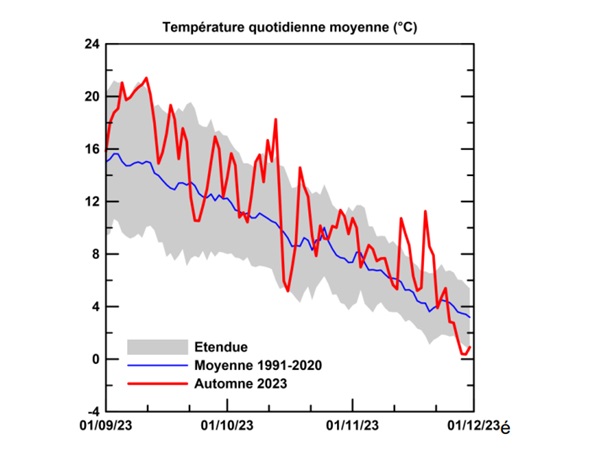 Average daily temperature in fall 2023 in Clemency (red) compared to reference period 1991−2020 (blue). The range is defined by the average of the minimums and maximums of the average daily temperature (in gray).;
Credit: AgriMeteo
Average daily temperature in fall 2023 in Clemency (red) compared to reference period 1991−2020 (blue). The range is defined by the average of the minimums and maximums of the average daily temperature (in gray).;
Credit: AgriMeteo
A new weather report has confirmed that autumn 2023 in Luxembourg was the second warmest since records began in 1838.
As autumn 2023 draws to a close, AgriMeteo, the national meteorological service of the Administration of Technical Agricultural Services (ASTA) of Luxembourg's Ministry of Agriculture, Viticulture and Rural Development, has published its weather analysis for the period from 1 September to 30 November 2023.
After the record autumn of 2006, the autumn of 2023 turned out to be the second warmest since records began in 1838, with an average temperature of 11.7°C and excess temperatures between +1.8° and +2.6°C compared to the 1991-2020 reference period. Autumn was also marked by a significant excess of rain, varying between +65.2 mm in Luxembourg City and +140 mm in Asselborn.
September 2023 was the fifth warmest since records began (temperatures between 16.5°C and 18.2°C), but drier than normal (between -37.2 and -3.5 mm, except one surplus of +4.8 mm in Asselborn).
October 2023 was also warmer than normal (excess between +1.7 and +2.5°C), and showed excess rain of up to +69.6 mm.
November 2023 showed an average of 6.3°C warmer than normal and excess rain between +46.5 and +81 mm. The first three weeks were very hot, but the month ended with a cold snap.
Consequences on agricultural crops
This out-of-the-ordinary weather influenced the growth of agricultural crops. High temperatures in September led to exceptional fall grassland growth in terms of quantity and quality.
The corn harvest generally took place with average volume, but exceptional quality. Some corn crops could not be harvested before the long period of rain. Most winter cereals were sown under very favourable conditions, although in some places the late maize harvest and the long rainy period delayed their sowing. The fields are currently saturated with water and impassable.
Summer conditions made it possible to extend the zucchini and tomato harvests. On the other hand, market garden species preferring cooler temperatures (mash, spinach, broccoli) began flowering. The growth of weeds has created an additional concern for market gardeners. The heavy rain in October interrupted the remaining crops (carrots, cabbage).
The heat brought forward the start of the crémant harvest to the week of 4 September. Winegrowers had to sort between juicy and mouldy bunches and harvested a smaller quantity of grapes. Apples and pears were harvested prior to the onset of October rains.








